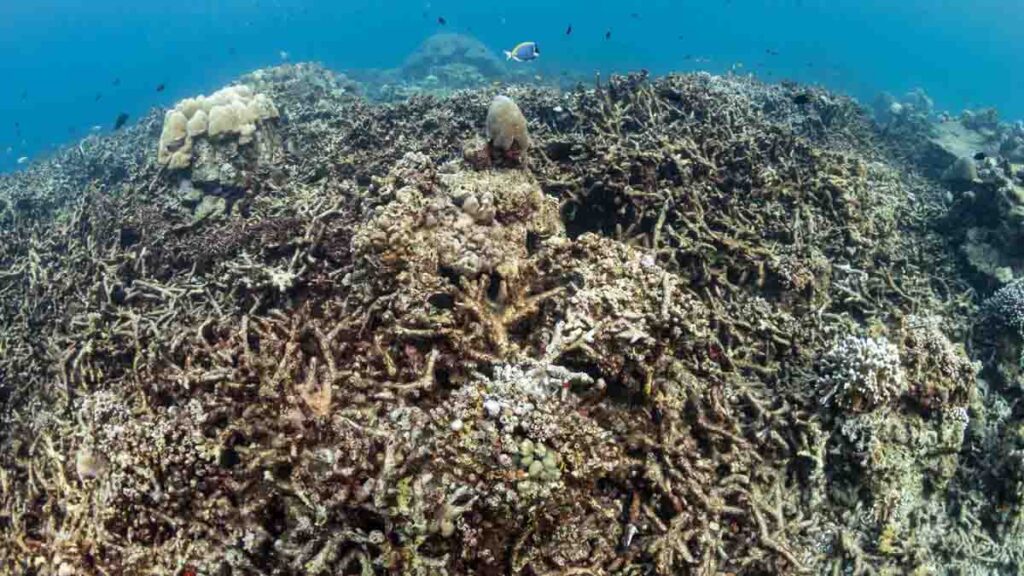
Summer is coming, and it’s time to protect yourself from the sun’s harmful rays. You might reach for a bottle of what you think is a harmless sunscreen, not realizing that hidden within its chemicals are ingredients that can cause harm to both your skin and the environment.
It’s time to switch up your suncare routine, learn about the risks of chemical-based sunscreens, and why you should switch to a chemical-free SPF. From how long it lasts in water and whether it blocks UVA and UVB rays to what happens when it ends up in coral reefs, we’ll cover everything you need to know about chemical-free SPF and why you should choose it over its toxic counterparts.
It’s common knowledge that too much sun can harm your skin. Still, you may not know that chemical sunscreens containing ingredients like oxybenzone and octinoxate are incredibly damaging to marine life; worried about protecting yourself from the sun? You should also be concerned about protecting the environment.
The harsh chemicals in most sunscreens are creating a cascade of environmental disasters. While swimming, these chemicals leach off your skin and into our waters, infiltrating coral reefs and disrupting the delicate balance of marine ecosystems.
These compounds have been connected to coral bleaching, weakening it until it’s unable to survive and damaging fish embryos, making them unable to hatch. It’s heartbreaking, all because you didn’t switch to a chemical-free sunscreen!
We’ve already seen some of the devastating effects these compounds can have on global reef systems, so it is time we take responsibility for our actions, and choose chemical-free sunscreens for our health and our planet’s wellbeing.

When applying chemical sunscreen, there are some common mistakes to be aware of. Firstly, don’t be fooled by labels that claim to be reef safe – they typically refer to physical SPFs only. In contrast, chemical sunscreens can damage the environment and marine life, even if they claim to be natural.
Secondly, ensure you apply enough sunscreen with every application – most people don’t apply enough and, as a result, leave their skin exposed. The Skin Cancer Foundation recommends using an ounce (equivalent to a full shot glass) of sunscreen at a time and reapplying every two hours.
Finally, remember not to forget your actions have consequences! Not only for yourself and your skin in the long run but for the environment too. Every time you use a chemical sunscreen, you risk damaging marine habitats, from coral reefs to other delicate ecosystems disrupted by ingredient dumping into the ocean.
By choosing an organically-derived SPF, you can reduce your impact on the environment and its inhabitants without sacrificing protection from harmful UVA/UVB rays.
So, what’s the flip side? Indeed mineral sunscreens must have a downside. Well, here’s the thing: mineral sunscreens are much better for your skin and far more sustainable and environmentally friendly too.
Unlike chemical sunscreens containing harsh synthetic chemicals, mineral sunscreens often use natural ingredients such as zinc oxide that protects against UVB and UVA rays. Not only is it better for your skin, but also it forms a physical barrier to shield from UV rays. Hence, you get longer-lasting protection and hydration due to being non-irritating and non-allergenic.
It’s not only better for your skin but also for our oceans! Chemical sunscreen ingredients kill coral reefs, but reef-safe sunscreens made with minerals that don’t penetrate the environment shield us from UV rays without poisoning precious marine life.
So if you care about your skin and the environment, switch to mineral sunscreen! They offer more protection (because they last longer on the skin’s surface) and protect our oceans.
You want the best protection you can get when it comes to skin. That’s why finding a chemical-free sunscreen is so important. Mineral sunscreens, sometimes labelled as ‘natural’ or ‘organic’, may offer better skin protection.
So what makes a mineral sunscreen better?
Unlike chemical SPFs, mineral sunscreens usually use zinc oxide and titanium oxide to physically block the sun’s UVA and UVB rays from penetrating your skin, keeping you safe from harmful radiation. This physical barrier also has one huge benefit many people don’t know about, mineral sunscreens don’t break down in the sun, so their protection stays consistent for long-term all-day use!
Mineral formulas might be your best bet if you have sensitive skin or are prone to annoying breakouts from traditional chemical sunscreens. Mineral formulas are often gentler on your skin since they don’t contain conventional active ingredients like oxybenzone or avobenzone. If you’re prone to irritation, you’ll appreciate that mineral-based SPF generally offers broad-spectrum protection without parabens or fragrances that can further irritate your skin.
If you’re on the hunt for an SPF that won’t damage your reef while still offering sensitive skin support, here are a few pointers:
Did you know it’s not just the chemical ingredients in chemical sunscreens that can damage you and the environment? There are other things to consider, too.
The problem with chemical sunscreens is that they rarely provide complete UV protection and can be harsh on sensitive skin types, not to mention the potential damage that chemical-based filters have on marine life. That’s why today, there are more and more chemical-free SPF options available, which are like sunscreen-lite.
Chemical-free sunscreens use natural ingredients, such as mineral or physical filters, like titanium dioxide or zinc oxide. These provide broad-spectrum UVA/UVB protection without irritating your skin.
The physical barrier created by topical zinc oxide and titanium oxide stays on the surface of your skin, which means they won’t run off when you’re in the pool or ocean. So you can enjoy swimming and surfing without worrying about reapplying. Now you have an option for your face without feeling greasy or sticky. Plus, these all-natural ingredients won’t cause harm to coral reefs or ocean life.
So if you’re looking for a sunscreen that won’t only protect you from UV damage but also help protect your environment, think natural— choose a chemical-free SPF with titanium dioxide and zinc oxide!
Apart from protecting against UVA and UVB radiation, mineral sunscreens are also perfect for water sports.
Mineral sunscreens usually offer a lightweight texture and are non-comedogenic. They won’t clog pores, cause congestion, or encourage breakouts. This makes them suitable for all skin types, including sensitive and acne-prone complexions.
Mineral sunscreens tend to offer longer-lasting protection than chemical formulas. The physical barrier created by the minerals lasts longer on the surface of your skin, so you don’t have to worry about reapplying every few hours. This is especially beneficial for outdoor activities or vacations during which you’ll be exposed to the sun for long periods.
Ultimately, choosing a mineral sunscreen comes down to personal choice and preference. From protection to hydration and convenience, mineral sunscreens have much to offer, even if you don’t spend too much time in the sun. So, why not try a chemical-free sunscreen

Are you wondering how to protect your skin and the reefs? We’ve got you covered.
Physical sunscreens are ideal solutions to keep your skin safe and healthy. They use natural minerals such as zinc oxide and titanium dioxide to provide broad-spectrum coverage. And that’s not all; these physical barriers protect against UVA and UVB rays, reflect heat, and form a protective layer on top of your skin.
Natural oils are one of the oldest forms of protection from the sun; think about the days when coconut oil was all the rage! Coconut oil is still a great choice if you’re looking for a natural solution. Borage oil is another popular option with moisturizing properties, such as olive and grape seed oil. Remember that these oils should be applied after sunscreen for a complete shield from UV rays.
When protecting yourself from sunburns and caring for your skin health, plenty of options don’t involve chemical-based sunscreen products! Not only will using natural sunscreen solutions save the reefs, but they’ll also provide better results for your skin in the long run.
In conclusion, chemical sunscreen isn’t doing us any favours regarding our health or our planet’s health. So, it’s time to get savvy about our sunscreen decisions for ourselves and the ocean. To play it safe, choose a mineral-based sunscreen labelled reef-safe or marine-safe, so you can rest easy knowing you’re doing right by the reefs and our skin.
Balmy Fox “On the Water” Sunscreen and SPF lip balm is an all-natural, mineral-based sunblock suitable for all ages. Due to the high level of natural oils butters, and waxes, it is a water-resistant and no-sting formula, ideal for those with sensitive skin, eczema and psoriasis.
